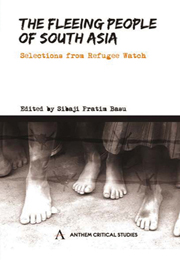Book contents
- Frontmatter
- Contents
- Acronyms and Abbreviations
- Foreword by Ranabir Samaddar
- Preface
- ETHICAL ISSUES
- LAWS
- SOUTH ASIA
- INDIA
- Introduction
- Population Displacement in India: A Critical Overview
- Reporting from Gagan Geer: A Kargil War Refugee Camp
- Barricaded Kashmiri Pandits Letting Go the Right to Return?
- Homeless and Divided in Jammu and Kashmir
- Internal Displacement in North-East India: Challenges Ahead
- The North-East Today: Displacing Identities, Displaced Identities
- Tibetan Refugees in India: Surviving in Exile
- Unrest and Displacement: Rajbanshis in North Bengal
- Adivasis in Coal Mining
- GENDER
- INTERVIEW/CORRESPONDENCE
- REPRESENTATIONS
- Index
Barricaded Kashmiri Pandits Letting Go the Right to Return?
from INDIA
Published online by Cambridge University Press: 05 March 2012
- Frontmatter
- Contents
- Acronyms and Abbreviations
- Foreword by Ranabir Samaddar
- Preface
- ETHICAL ISSUES
- LAWS
- SOUTH ASIA
- INDIA
- Introduction
- Population Displacement in India: A Critical Overview
- Reporting from Gagan Geer: A Kargil War Refugee Camp
- Barricaded Kashmiri Pandits Letting Go the Right to Return?
- Homeless and Divided in Jammu and Kashmir
- Internal Displacement in North-East India: Challenges Ahead
- The North-East Today: Displacing Identities, Displaced Identities
- Tibetan Refugees in India: Surviving in Exile
- Unrest and Displacement: Rajbanshis in North Bengal
- Adivasis in Coal Mining
- GENDER
- INTERVIEW/CORRESPONDENCE
- REPRESENTATIONS
- Index
Summary
In the ten years of insurgency in the Kashmir valley and the border hill districts girdling the epicentre of conflict, more than half a million people have been displaced on both sides of the Line of Control (LOC). The exodus includes, 200,000 Kashmiri Pandits, 70,000 Kashmiri Muslims to India and 120,000 to Pakistan. From Kargil and the border districts some 35,000 people have been displaced in Pakistan and 100,000 in India.
As the guns fall silent along the LOC, after the Kargil war, the people of the border districts will return to bury their animals, rebuild their homes and replant their crops till the artillery duels across the LOC erupt again. But for the thousands of displaced Kashmiri Pandits, can there be a return home? Can there be a return to the ‘homeland’, a return to a remembered society imbued in the ethos of Kashmiriyat i.e. a common Muslim–Pandit identity constructed around a shared history, language and culture?
The mass exodus of Pandits from the valley in 1990 played into the hands of the propagandists on both sides and people who had grown up in a culture of social and economic interdependence have been communalized. The poison of communal politics has constructed negative images of the Pandit as abandoning his Muslim brethren to the guns of the Indian state and the Muslim as waiting to grab the property of his Pandit neighbour.
- Type
- Chapter
- Information
- The Fleeing People of South AsiaSelections from Refugee Watch, pp. 239 - 243Publisher: Anthem PressPrint publication year: 2009



